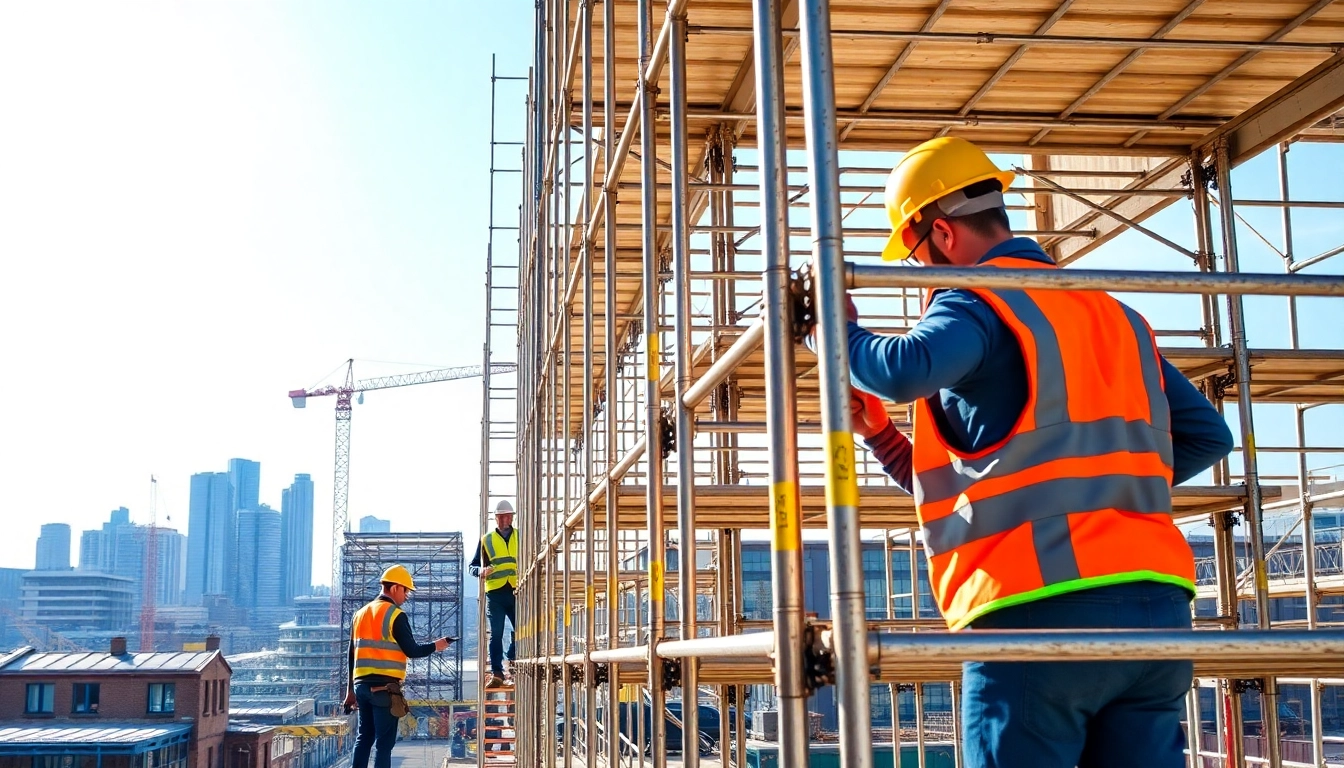Understanding Scaffolding in Manchester
What is Scaffolding?
Scaffolding is a temporary structure used in construction to support work crews and materials during the building process. It provides a secure platform for workers to reach heights while also facilitating the transport of heavy materials. Commonly made of metal, scaffolding enhances safety by allowing construction workers to operate in elevated areas without the risk of falling or unsafe access. Proper scaffolding systems are vital for various construction activities, from renovation of homes to constructing skyscrapers, ensuring that the project proceeds efficiently and safely.
Types of Scaffolding Available
In Manchester, as in many cities, various types of scaffolding systems are employed to suit different construction needs. Each type offers unique advantages:
- Tube and Fitting Scaffolding: This traditional type involves metal tubes and fittings that can be assembled in various configurations. It’s highly versatile and suitable for complex structures.
- System Scaffolding: Pre-fabricated components make this type easier and faster to erect. It’s often used for large projects where speed is crucial.
- Mobile Scaffolding: These are smaller units on wheels, allowing for easy relocation. Perfect for indoor and smaller outdoor tasks where mobility is essential.
- Formwork Scaffolding: This type supports formwork for concrete projects, ensuring the right shape while the concrete is poured and cured.
Importance of Scaffolding in Construction
The importance of scaffolding in construction cannot be overstated. It not only provides access to difficult-to-reach areas but also supports workers and materials, improving efficiency. Scaffolding plays a critical role in ensuring worker safety, which is paramount in the construction industry. Without robust scaffolding:
- The risk of accidents significantly increases, potentially leading to injuries or fatalities.
- Work can be slowed down due to unsafe access, ultimately increasing project costs.
- Quality may be compromised if workers cannot properly reach areas requiring attention.
Therefore, the use of appropriate scaffolding structures is essential for any construction project in Manchester.
Choosing a Scaffolding Provider in Manchester
Key Qualities to Look For
When selecting a Scaffolding Manchester provider, it is crucial to focus on several key qualities that can make or break your construction project:
- Experience: Look for companies with a proven track record in the industry. Experienced providers understand the nuances of scaffolding and can advise on the best practices for your specific needs.
- Safety Compliance: Ensure that the provider adheres to local laws and safety regulations. This compliance is not only essential for safety but also for avoiding fines and project delays.
- Quality of Equipment: The scaffolding’s materials and design should meet high standards. Poor-quality scaffolding can pose safety risks and may need frequent repairs or replacements.
- Customer Service: A responsive company that listens to your concerns and provides support is invaluable. Effective communication is key to the success of any project.
Questions to Ask Your Scaffolding Company
Before finalizing your choice, it’s essential to have open conversations with potential scaffolding providers. Here are some critical questions to consider:
- What safety measures do you implement? Understanding how a company prioritizes safety can provide peace of mind.
- Can you provide references or case studies? Past performance can be a good indicator of future reliability and quality.
- What is your process for scaffold installation and removal? Knowing this helps gauge efficiency and reliability.
- Do you have insurance coverage? Checking for proper insurance can protect you in case of accidents or damage.
Comparing Quotes for Scaffolding Services
Cost is often a significant factor when choosing a scaffolding provider. However, it’s crucial to avoid basing your decision solely on price. When comparing quotes, consider the following:
- Scope of Service: Are the quotes inclusive of installation and dismantling? Does the provider offer ongoing support throughout the project?
- Quality vs. Cost: The cheapest option may not always be the best. Assess the quality of materials and service alongside costs.
- Flexibility: Can the provider accommodate changes in your project? Flexibility can save time and money in the long run.
Safety Regulations for Scaffolding in Manchester
Local Safety Standards and Guidelines
In Manchester, scaffolding practices are governed by specific safety regulations aimed at protecting workers and the public. According to the Health and Safety Executive, scaffolding must comply with the Work at Height Regulations 2005 and other relevant legislation. Essential requirements include:
- Use of proper materials and design to ensure structural integrity.
- Regular inspections to identify and rectify potential hazards.
- Provision of adequate training for workers using scaffolding.
- Clear signage and barriers to ensure the safety of passersby.
Best Practices for Scaffolding Safety
Adhering to best practices is vital to ensure safety during scaffolding projects:
- Conduct thorough inspections before beginning a project and after any significant weather events.
- Mark out areas around scaffolding zones to keep unauthorized personnel at a safe distance.
- Ensure that all workers are trained and familiarized with safety protocols.
- Utilize safety harnesses and guardrails in line with UK regulations.
Common Safety Violations to Avoid
Failure to adhere to safety regulations can result in serious consequences. Common violations often include:
- Not providing fall protection systems.
- Overloading scaffolding beyond its specified weight limit.
- Failure to inspect the scaffolding regularly or after severe weather.
- Using defective or inadequate equipment.
By being aware of these common issues, scaffolding companies can not only protect their workers but also enhance their reputation with compliance.
Scaffolding Installation Process
Steps for Efficient Scaffolding Setup
The successful installation of scaffolding relies on a systematic approach:
- Planning: Evaluate the site requirements and determine the type of scaffolding needed.
- Preparation: Clear the work area of any obstacles, and ensure the ground is level to support the weight of the scaffolding.
- Assembly: Follow manufacturer guidelines or industry standards to correctly assemble the scaffolding. Engage trained personnel for this task to avoid injuries.
- Inspection: Before use, conduct a thorough inspection to confirm stability and safety, making sure all components are correctly connected.
Common Challenges in Scaffolding Installation
Scaffolders can encounter various challenges during installation, including:
- Weather Conditions: High winds or rain can delay installation and may require temporary halts for safety.
- Site Constraints: Limited space or unique architectural factors may complicate the setup process.
- Material Shortages: Delays in material delivery can disrupt project timelines and necessitate backup plans.
How to Ensure Stability and Safety During Construction
To maintain stability and safety throughout the project:
- Regularly monitor and assess the scaffolding during use.
- Utilize cross-bracing and ties to increase stability.
- Ensure that loads are evenly distributed, avoiding heavy concentrations of weight.
Maintaining Scaffolding Structures
Inspection Guidelines for Scaffolding
Regular inspections are mandatory for maintaining scaffolding integrity. Inspections should occur:
- Before the start of the workday.
- After severe weather or any incident that may have impacted the scaffolding.
- At regular intervals throughout lengthy projects to ensure compliance with safety standards.
Signs of Wear and Tear to Watch For
Be vigilant for signs that the scaffolding may need repairs or replacement:
- Visible rust or corrosion on metal components.
- Loose parts or missing components that may affect stability.
- Cracked or damaged boards that can jeopardize worker safety.
Maintenance Best Practices to Follow
To ensure scaffolding remains safe and effective over time:
- Implement a routine maintenance schedule that includes cleaning and repairs of all components.
- Keep logs of inspections and maintenance activities as part of compliance practices.
- Train personnel on proper handling and maintenance procedures to prevent damage and prolong the life of the scaffolding.

